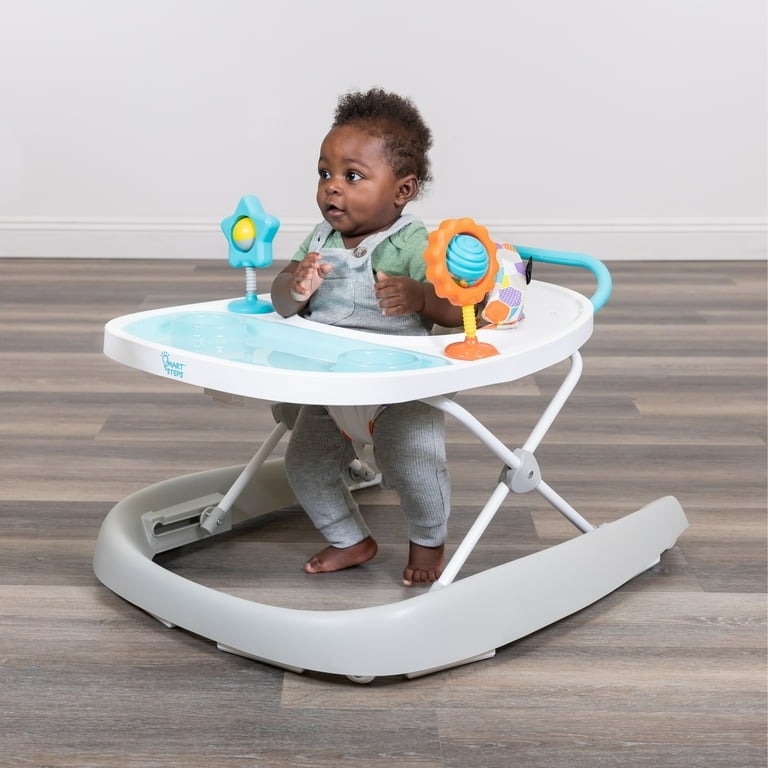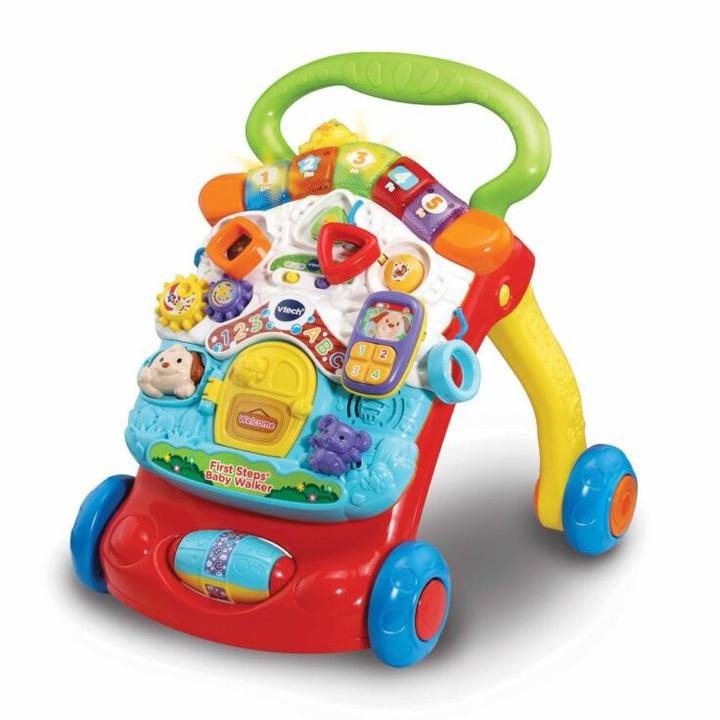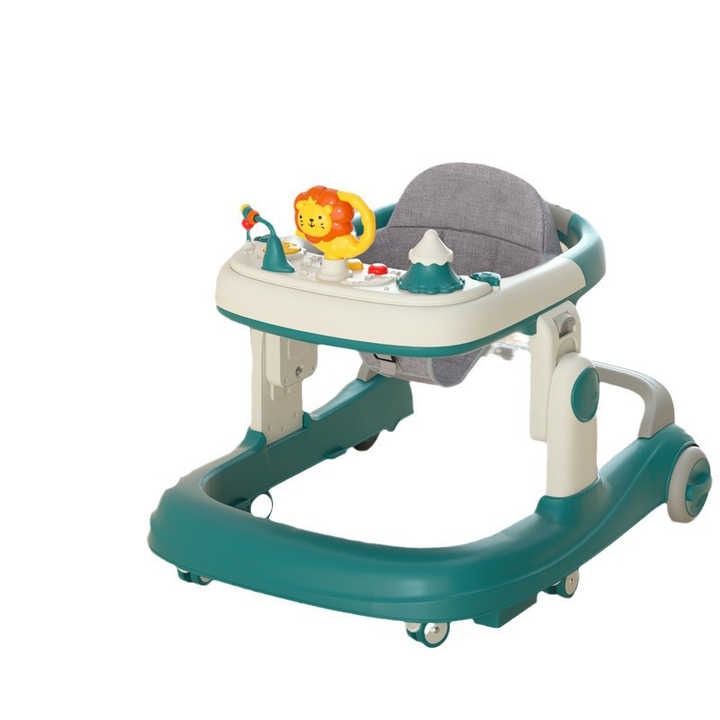Types of Baby Walkers and Their Safety Features
Choosing the right baby walker is vital for your infant’s safety and development. Baby walkers come in various forms, each with unique safety features. Here’s a breakdown of the most common types:
Traditional Sit-in Baby Walkers
Sit-in walkers typically have a seat suspended in a frame on wheels. These walkers offer several safety features:
- A wide base to prevent tipping over.
- Speed-reducing mechanisms to control movement.
- Comfortable, supportive seats that adjust as your baby grows.
Modern Push Walkers
Push walkers, sometimes called push-along walkers, require the baby to stand behind and push. They also have safety features:
- Sturdy handles to support early walkers.
- Non-skid wheels to enhance grip and stability.
- Activity panels that secure engagement without movement.
Convertible Baby Walkers
Convertible walkers can transform from sit-in to push walker as your baby’s mobility progresses. These walkers combine safety elements from both types:
- Adjustable speed settings for growing skill levels.
- Locking mechanisms to convert safely between modes.
Seated Walkers with Activity Trays
This type of baby walker goes beyond mobility, featuring trays with toys and activities:
- High-back seats for added support and posture development.
- Extra padding around the edges to protect fingers.
For each baby walker type, look for additional safety features like anti-slip pads, locks that prevent stairs descent, and durable materials. Ensuring that the baby walker has passed stringent safety tests can give parents peace of mind. Remember to check for a baby walker’s compliance with safety standards and certifications, which we will discuss later in this blog. By understanding these types and their safety features, parents can make an informed decision on which baby walker suits their child the best.
Key Safety Considerations When Buying a Baby Walker

When purchasing a baby walker, safety should be your top priority. Here are the essential factors to consider:
Stability and Construction
Choose a walker with a wide, stable base. This design helps prevent the walker from tipping over. Ensure that the materials are robust and durable for prolonged use.
Adjustable Height Features
Look for walkers that offer adjustable height settings. This ensures the walker grows with your baby, maintaining proper posture and support.
Speed Control Mechanisms
Select models that include speed-reducing features. These mechanisms help manage the walker’s pace, preventing runaway movements.
Safety Certifications
Always check that the baby walker complies with the latest safety standards. Reliable certifications indicate that the product has undergone extensive safety testing.
By focusing on these key safety considerations, you can ensure a safer experience for your baby. Each feature contributes to the overall safety and functionality of the baby walker.
The Role of Age and Size Compatibility in Choosing a Baby Walker
When selecting a baby walker, age and size compatibility are crucial. This ensures comfort and safety as your baby grows. Here are key factors:
Age Appropriate Design
Pick a baby walker suitable for your infant’s age. Age-appropriate features prevent strains and support proper development.
Adjustable to Baby’s Size
Choose a walker that adjusts to your baby’s size. It should grow with your child for optimal use.
Weight Limits
Check the weight limit specifications of the baby walker. It must support your baby’s current and future weight securely.
By considering age and size when choosing a baby walker, you provide a better and safer experience for your infant.
Pros and Cons of Sit-in vs. Push Baby Walkers
Choosing the right type of baby walker is important for your baby’s safety and development. Here, we’ll discuss the advantages and disadvantages of sit-in versus push baby walkers to help parents decide.
Advantages of Sit-in Baby Walkers
- Support and Safety: They provide a supportive seat which helps babies who can’t fully stand on their own.
- Enclosed Structure: This minimizes the risk of babies reaching out to dangerous objects.
- Entertainment: Many come with activity trays to keep your baby engaged.
Disadvantages of Sit-in Baby Walkers
- Mobility Issues: Can be heavy and harder for babies to maneuver.
- Stair Risk: There’s a higher risk of accidents on stairs if not used under supervision.
- Leg Development: There’s a concern that they can impact a baby’s natural walking development.
Advantages of Push Baby Walkers
- Motor Skills: Promote better development of walking and balancing skills.
- Flexibility: They can be lighter and easier to control.
- Multi-use: Once babies learn to walk, they can still use the walker for support.
Disadvantages of Push Baby Walkers
- Less Stable: Without a seat, there’s a higher chance of a baby falling.
- Requires Strength: They need the baby to have some ability to stand and walk.
- Distractions: The lack of an activity tray can make them less engaging for longer periods.
Both sit-in and push baby walkers have their benefits and drawbacks. The key is to consider your baby’s age, strength, and motor skill development. Remember, supervision is essential no matter what type of baby walker you choose. Always refer to safety certifications and check that the baby walker fits your child properly for an optimal experience.
Important Safety Certifications for Baby Walkers

When purchasing a baby walker, safety certifications are key. Here’s what to look out for:
Look for JPMA Certification
The Juvenile Products Manufacturers Association (JPMA) sets high safety standards. A JPMA-certified baby walker undergoes rigorous testing. It meets or exceeds safety requirements.
Check for ASTM Standards
ASTM International outlines global safety standards. Ensure your chosen baby walker complies with ASTM standards. It ensures top safety and quality.
Seek CPSC Compliance
The Consumer Product Safety Commission (CPSC) ensures products are safe for use. A walker compliant with CPSC guidelines reduces risks of harm.
Verify Additional International Certifications
Depending on your location, look for relevant international certifications. These may include the European EN, the Canadian SCC, or others that apply to baby walkers.
Aiming for baby walkers with these key safety certifications can keep your infant secure. Remember, these certifications show that a product is tested and verified. They help prevent accidents and injuries. Always check the labels and product information for these important marks of safety.
How to Use a Baby Walker Safely: Tips for Parents
Ensuring the safe use of a baby walker is essential for your child’s protection. Here are some practical tips every parent should follow:
Always Supervise Your Baby
Never leave your baby unattended in a walker, even for a short time. Close supervision prevents accidents.
Use on Flat Surfaces
Operate the baby walker on even, flat surfaces to avoid tipping and falls. Avoid stairs and inclines.
Set Speed Settings
If the walker has adjustable speeds, start with the slowest. It gives better control and safety.
Limit Usage Time
Restrict walker use to short periods. It helps prevent overdependence and promotes natural walking skills.
Keep Hazardous Objects Away
Clear the area of sharp objects, hot drinks, and anything that can cause harm. Safety comes first.
Inspect the Walker Regularly
Check for damage or wear before each use. A well-maintained walker ensures safety and longevity.
Follow Assembly Instructions
Assemble the walker precisely according to the manual. Proper assembly prevents malfunctions.
Encourage Natural Movement
Use the walker to complement, not replace, natural crawling and walking. Balance is key for development.
These safety tips, along with selecting a baby walker with top safety certifications, contribute to a safer environment. Always consider the baby walker’s age and size compatibility to provide a perfect fit for your child. By combining these safety measures with vigilant supervision, parents can feel more assured about their baby’s mobility and protection.
Top Safety-Reviewed Baby Walkers on the Market in 2024
Choosing a top-rated baby walker in 2024 involves looking at the latest safety reviews. Here, we highlight some of the best options available, considering rigorous safety standards and parent feedback.
Fisher-Price Bright Beginnings Walker
This walker scores high for stability and robust construction. It adapts easily to different heights, suiting growing babies. Its wide base reduces the risk of tipping over.
VTech Sit-to-Stand Learning Walker
Known for its interactive learning features, this model meets stringent ASTM and JPMA standards. It helps in developing motor skills and is highly recommended for its durable design.
Joovy Spoon Walker
The Joovy Spoon combines eating, playing, and learning in one unit. It features a large tray and a comfortable padded seat. The strong build and safety locks make it a safe choice for babies.
Chicco Walky Talky Baby Walker
This fun, multilingual walker aids in language development and offers various entertainment options. It guarantees compliance with international safety standards, including CPSC and EN.
Safety 1st Dino Sounds ‘n Lights Discovery Walker
Not only does this walker entertain with lights and sounds, but it also ensures safety with sturdy wheels and brakes. It’s easy to store and clean, making it convenient for parents too.
These baby walkers have been evaluated for safety features like brakes, non-toxic materials, and ergonomic design, ensuring a secure environment for your little one. Each model listed here stands out in the 2024 market for its safety, quality, and user satisfaction. Parents should always verify the latest safety certifications and ensure the walker fits their child’s current size and weight.
Alternative Solutions to Baby Walkers for Infant Mobility

While baby walkers can be helpful, alternative options also promote safe infant mobility. Here are some worth considering:
Stationary Activity Centers
These centers provide a secure play area. They often come with toys and activities attached. Unlike baby walkers, they don’t move, making them safer around stairs and uneven surfaces.
Baby Jumpers
Baby jumpers allow mobility and strengthen leg muscles. Ensure they are firmly secured to door frames or come with a stable base structure.
Floor-Based Playmats
Interactive playmats are great for encouraging crawling. They help develop motor skills without the risks associated with movement.
Push Toys
Once a baby can stand, push toys can be a safe alternative. They help improve balance and walking skills under supervision. Look for push toys with broad, stable bases to prevent tipping.
These alternative methods can reduce the risk of accidents and foster safe development.